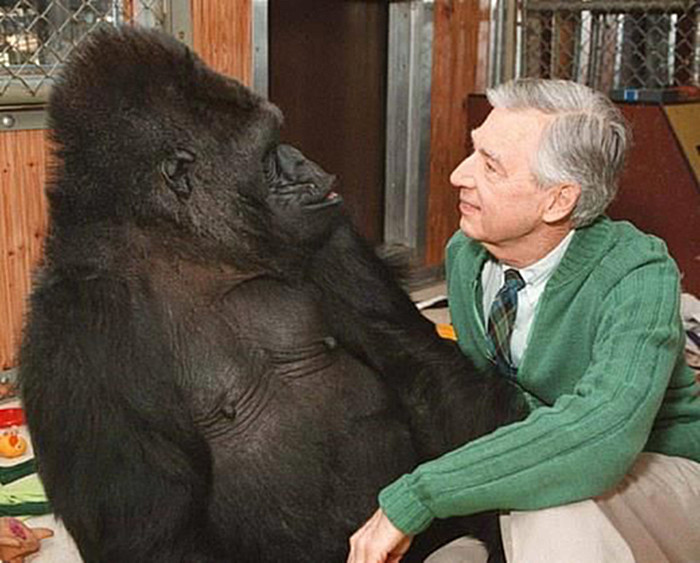There are many examples of animals that have been forced to adapt to human forms of communication. Often this is called “intelligent” behavior. Clearly there is something deeply problematic with the idea that intelligence can be measured by simililarity to human forms of thought and communication. Here are nevertheless a few interesting examples from a Ted talk.
Koko the Gorilla. Psychologist Francine Patterson started teaching this famous lowland gorilla American Sign Language over forty years ago. Patterson and her collaborators claim that Koko now knows over 1,000 signs and can understand around 2,000 verbal words. For more information, see the Gorilla Foundation website or check out Koko’s YouTube channel.
Kanzi the Bonobo. Psychologist and primatologist Sue Savage-Rumbaugh has been studying Kanzi, another great ape, since 1980, first at the Yerkes Regional Primate Research Center in Atlanta, then at the Language Research Center at Georgia State University, and now at the Bonobo Hope Sanctuary in Iowa. Kanzi interacts with Savage-Rumbaugh and other handlers via a specialized keyboard with symbols on the buttons. According to the researchers, Kanzi knows 600 words, and he can also allegedly communicate with them verbally. For more information, go to the Bonobo Hope website or listen to this great episode of Radiolab. And of course, watch her TED Talk “The gentle genius of bonobos” »
Nim the Chimpanzee. This controversial research project launched in 1973 sought to find out if a chimpanzee living in a human family could learn to communicate using a version of American Sign Language. Baby chimpanzee Nim was taken from his mother in a primate research center just days after birth and placed in a home with a Columbia University psychology grad student and her three children, under the direction of professor Herbert Terrace. The amazing 2011 documentary Project Nim chronicles the project, which had Nim living with multiple families, working day in and day out to learn words and sometimes even drinking and smoking with his human handlers. The doc reveals much regret on the part of the experimenters and answers the uncomfortable question of what happened to Nim after the project was shut down.
Peter the Dolphin. Also in the highly controversial realm: neuroscientist John C. Lilly’s work with dolphin communication in 1958, which Mental Floss recently called one of “4 Bizarre Experiments that Should Never Be Repeated.” Interested in whether dolphins could learn language through constant contact with humans, Lilly had a male dolphin named Peter live with a female research associate, Margaret Howe, for 10 weeks in a home filled with enough water so that Peter could swim and Howe could wade. Howe slept in a water-logged bed and taught Peter English lessons, with him imitating the sounds she made and learning to retrieve objects on command. But the ultimate result of the experiment: Peter began to show sexual aggression toward Howe. Lilly wrote about this experiment, and his other work with dolphins between the years 1955 to 1978, in this book.
Alex the African Grey Parrot. Mammals aren’t the only communicative animals. Irene Pepperberg’s famous parrot, Alex, knew over 100 English words, could count up to six (and sometimes to eight), and could identify various shapes and colors. Alex died unexpectedly in 2007 at the age of 31 (just middle age for such a parrot), but Pepperberg continues her research with other birds. To learn more, check out the Alex Foundation website or watch this short Nova documentary.
